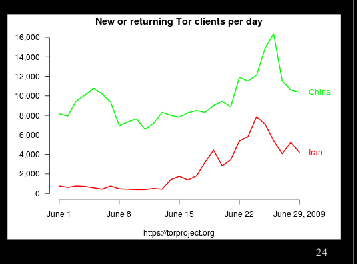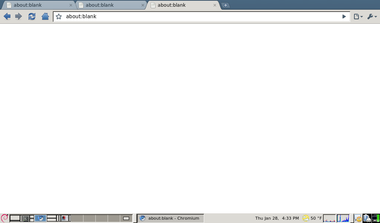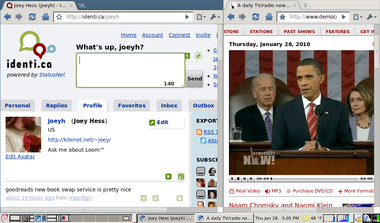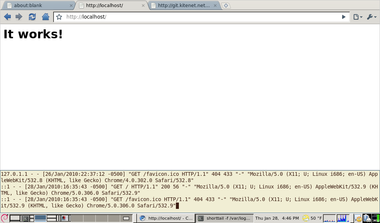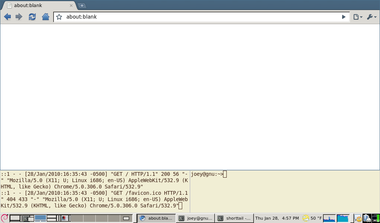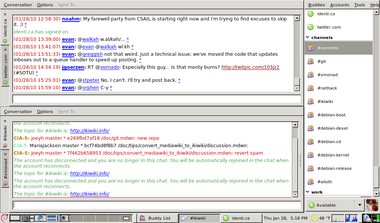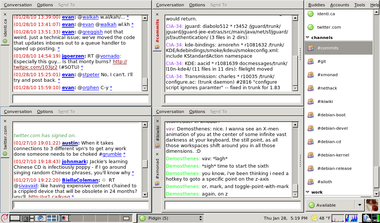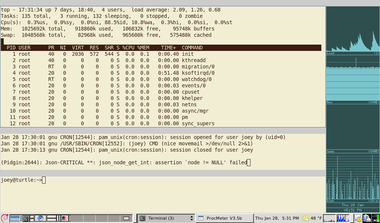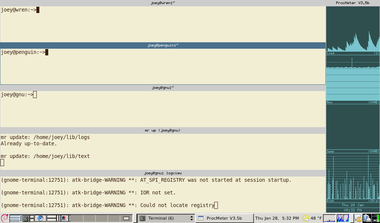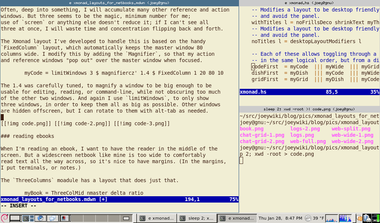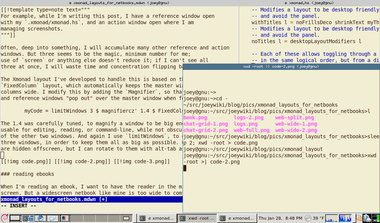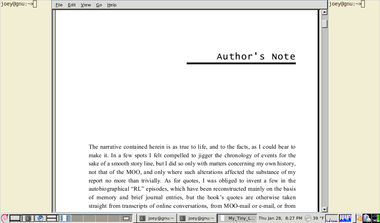This has been a big decade for me.
Ten years ago, I was living in Sunnyvale, in the heart of Silicon Valley; VA had just had its crazy IPO; my unvested options were worth over a million dollars on paper. I remember sitting in first class[1] on the way out of Atlanta after the holidays and wondering what one did with a million dollars. Avoid working too much? Have a lot of interesting computers? Build a distributed house[2]? Mostly I decided to not count my chickens, which turned out to be the right choice.
Six months later, I started debian-installer, in many ways my biggest project to date.
In spring of '01, VA was crashing; I was sick of the Valley; gloom was everywhere. I took the hint and quit, cashed in my options for five figures, not seven, bade forewell to the many people I'd come to know, and moved back east.
By reading my old journal, I can tell that subconciously, I had long before decided what to do when it was time to leave the Bay Area. So without really thinking too much about why I was able to do this, about how not just my own family, but others were indirectly making it possible, I moved to a 150 acre wooded "farm", and mostly went off and did mostly my own thing for three years.
This was such a huge life change. I lived in a building affectionatly called "the shack". It was renovated from a chicken coop in the 70's and leaked during heavy rain, but I preferred it to the main house (warmer). I went back to dialup for internet. I hauled groceries and most everything half a mile in by hand. There was an outhouse and washwater hauled from a creek. I cut barely enough firewood and readapted my body from California to cold.
My main tech project during this time was mooix. In some ways my largest failed project, but it was neat to be able to go off and do such a thing.
This was a blissful, reflective, peaceful, amazing time. Parts were a second childhood. Somewhere in there I properly confronted my mortality. And learned to use a chainsaw. And over the course of three years, I dug myself into a rut, a hole. I wasn't going anywhere.
(Except for a month in Honduras, and my first DebConf in Oslo.)
In '04, I found myself talking on the phone to a cosmonaut in a house that had been without power for days in a hard winter. I realized I was ready to leave the farm if I could figure out how to do it, and I almost took him up on the job working on his new Linux distro -- but at the last minute Oslo connections suggested I work for SkoleLinux instead, and so I did.
Soon after moving into a rented house in town, I was jaunting off to Brazil for a month, a great time. Followed by a productive year where I got heavily back into debian-installer, started Debian's testing security tream, and generally worked a lot.
The next summer I fooled around with an RV, and sort of fell into a job with ADS. But my time on the farm had changed me, I think. I ended up going back to the farm for a year and working part time from there. During this time I also started ikiwiki and other smaller projects.
One day I came back from a camping trip and found the kitchen had been torn down in my absence. Reminded unsubtly that I was not the only one with a claim to the place, I got out, though I somehow suspect not for good.
For the last four years, I've been more outwardly settled, buying a house in town, continuing to work at the same job, starting little projects like pristine-tar, mr, and etckeeper. About two years in I began to feel antsy sometimes (and had a minor medical scare), and set up the yurt as a relief valve so I can have crazy adventures in the cold woods again. Still, I sometimes feel that a big change is building up.
From here, this decade feels like it contained endless changes, important decisions, interesting projects, strong experiences. The 90's, containing only little things like college and moving to California, pale in comparison. Maybe the naught's will be the decade I always remember.. or maybe not. Anything could be around the corner.
Bumped up due to an airline scheduling snafu, not because I was throwing money around.
Concept of mine perhaps not worth explaining here although it was oddly similar to how I ended up living at the farm. Good ol' subconcious..
Here is a great talk from the Chaos Communication Congress about Tor and censorship: lessons learned. It's the inside scoop from the Tor guys on how they're keeping Tor usable inside China, Iran, etc despite attempts to block it.
If you're like me, you have resources and would like to help Tor, but the exposure of running a exit node is way too high, and even running an non-exit node seems risky. Now there's a third option, running a bridge which can be used to get to the Tor network.
The great thing about doing this is that you can be pretty sure anyone using your Tor bridge is the kind of person you want to help (and not some spammer or worse). There's little reason to use a Tor bridge unless your ISP/Government is repressing you. Also, the worst thing that is likely to happen to your bridge is that $COUNTRY discovers its IP and blocks it. So the benefits seem focused and high, and the risks easily managed.
I've hooked one of my laptop's terminals up to the net, so anyone with IPv6 can telnet in and see it.
I've long wanted to be able to broadcast my terminal sessions on occasions when it makes sense. Like when I'm fixing someone's bug, or closely collaborating with someone distant.
I am also interested in finding things to host on IPv6. Right now, that means only people who care will be able to access it. So it seems the trick is to find places where that is a benefit. I plan to keep an eye out for more things like this.
(A side benefit of using IPv6 is that it makes it easier to serve content from my laptop, that moves from network to network.)
I tried switching from identi.ca to brainbird today, when my always present frustration with 140 character limit in microblogging boiled over. Again. In the process, I've found some warts in the OpenMicroblogging system, beyond its obsession with fitting into an obsolete sideband communication medium that I will never actually use. Rant mode on.
Let's assume that OpenMicroblogging catches on, in a big way, and we're all using it in 10 years. So, it will be something like email. And its federated design allows for that; there can be multiple servers that communicate, and so on. (Which is a very good thing, compared to the twitter monoloth.)
But: How many times have you changed your email address? When you did,
you probably set up a .forward for the old email address, and emailed
some people from the new address to let them update their address book,
and it was not a big deal. But the experience when changing an
OpenMicroblogging site is not the same. You have to go out and re-follow
everyone. For each person, you have to go through a multiple screen
(OAUTH) process. This process may not even be automatible.
Second problem is that OpenMicroblogging does not use addresses. So to talk to me, one uses ´@joey'. It's not clear to me how sites determine whether to direct that to joey@identica or to joey@brainbird. Seemed like, if I switched to brainbird, I would need to pick a new username, to avoid having to check both places.
Finally, the OpenMicroblogging spec, while really quite a neat approach to piggyback on OAUTH, has some absurd limits. 140 characters for a biography. Even the limit for one's full name is longer than that. Absurd. Suprisingly, no 140 character limit on messages actually exists, that's just a recommendation. But it's unclear how a system that sends a longer message interoperates with systems that use shorter messages. Probably the message will be truncated. And there is no way in the protocol to discover the message limit of a remote system.
All in all, I think I prefer RSS, or Google Wave, or even IRC from a protocol perspective. And from a usability perspective, Facebook does not have absurd message limits, and most people read my messages there anyway.
Meh.
How a window manager with tiling layouts makes a 1024x600 resolution livable.
I spend a lot of time in front of a screen, and for the past year I have used only my netbook. No desktops, no laptops. Just a cheap $200 computer that is nearly a kid's toy. The most challenging thing about this is dealing with the 1024x600 screen resolution. When I moved to this screen from something with many more pixels, it at first seemed very cramped.
After a year, I think that the most important part of coping with the small screen is the flexability and customizability of layouts provided by the Xmonad window manager. In this post I will explain a few layouts I have developed for fitting specific tasks onto the netbook screen.
(I assume that you know maybe 0.1% of Haskell (about what I do), and can read Haskell code without having a brain aneurysm.)
web browsing
It's important that the web browser have as few toolbars and other cruft as possible, as horizontal space is especially at a premium. I've configured both Epiphany and Firefox to put everything in one tool bar. But now I use Chromium, which comes pre-configured that way.
What the netbook is designed for. You just want a web browser, taking up
the full screen, and with its own tabs. So far, so easy: that's Xmonad's
Full layout.
But, you sometimes want to see two websites side-by-side. This layout
accomplishes that, allowing the sizes to be adjusted as needed. It also
uses Xmonad's Magnifier to zoom the smaller window when it's focused,
which is useful if you briefly need to see more of a web site.
mySplit = magnifiercz' 1.4 $ Tall nmaster delta ratio
where
-- The default number of windows in the master pane
nmaster = 1
-- Percent of screen to increment by when resizing panes
delta = 3/100
-- Default proportion of screen occupied by master pane
ratio = 60/100
web development
If you're doing web development, you'll want probably one big web browser
window, but also with a nice wide terminal on the same screen, in order to
see web server logs. A simple way to do this is to mirror Xmonad's Tall
layout by 90 degrees.
myWide = Mirror $ Tall nmaster delta ratio
where
-- The default number of windows in the master pane
nmaster = 1
-- Percent of screen to increment by when resizing panes
delta = 3/100
-- Default proportion of screen occupied by master pane
ratio = 80/100
The myWide layout uses the full screen width for a single terminal,
and splits the width when there are more. This is sufficient for viewing logs
and doing minor things at the shell prompt, in between testing the result in
the web browser. Of course a terminal can be temporarily moved to the master
area by pressing mod-return, if you need it to be larger.
chat
Tips on configuring Pidgin for a netbook: Set it up to use vertical tabs to save horizontal space. Configure the input area to only 1 line tall, and turn off as much other cruft as you can. The menu bars, sadly, cannot be disabled, nor can the excessively large borders. In my screenshots, you can see that stuff wasting space that could be used to show four more lines of text.
For chat, you want to put the buddy list on the side of the
screen, and use the rest for conversation windows. Xmonad's IM module
takes care of allocating a sidebar on the screen for the buddy window. The
rest of the screen can be occupied by any layout you choose.
I like to have the conversation windows be as wide as possible, and
typically only want to see two conversations at a time. But sometimes I
might have a dozen visible. A good layout to cope with those needs is
Grid.
myChat' l = withIM size roster l
where
-- Ratio of screen roster will occupy
size = 1%5
-- Match roster window
roster = Title "Buddy List"
myChat = myChat' Grid
The withIM layout puts the buddy list on the left; I prefer it on the right
for some reason, so I tweaked my layout to do that. All it took was
using the reflectHoriz layout modifier to get a mirror image of
the layout. Then I reflect the inner layout back to its normal orientation.
Being able to throw in a few function calls and mutate a layout like that
is where Xmonad shines.
myChat' l = reflectHoriz $ withIM size roster $
reflectHoriz $ l
logs
Ever notice that tail -f wastes the last line of the terminal? On a netbook
this matters.
shorttail
lets the last line be used.
I have a dedidated workspace that I use to tail logs, and as a place to
send long-running tasks (such as compiles). The layout for this needs to
keep windows wide, to see whole logged lines, but they need only be five
or so lines tall. And it's convenient to have one bigger window with the
small ones below. Xmonad has a perfect layout for this, called Dishes,
because it's sorta like a stack of plates.
myDish = limitWindows 5 $ Dishes nmaster ratio
where
-- The default number of windows in the master pane
nmaster = 1
-- Default proportion of screen occupied by other panes
ratio = 1/5
In the second screenshot above, I have 6 windows open, but only 5 are
visible. The limitWindows 5 accomplishes this. It's handy mostly because
gnome-terminal has a bad habit of crashing when resized to 0x0.
(That's gotta be a bug in something!)
Notice that the screenshots above also have Procmeter in a sidebar on
the right. I (ab)used the withIM layout to do that:
myLogs' l = reflectHoriz $ withIM procmeterSize procmeter $
reflectHoriz $ l
where
-- Ratio of screen procmeter will occupy
procmeterSize = 1%7
-- Match procmeter
procmeter = ClassName "ProcMeter3"
myLogs = myLogs' myDish
coding
Everything above was easy. Doing coding (or writing) on a small screen is where it gets hard. When I'm coding I want to have one window that is exactly 80 columns wide, and as tall as possible, where I do the main development. Then I need a minimum of two other windows also visible: one action window for running tests and the like, and one to view references (emails, man pages, other files, etc). I may need to view any of these windows fullscreen at any time, of course.
As an example of the three window rule:
While I'm writing this post, I have a reference window open
with my .xmonad/xmonad.hs, and an action window open where I am
managing screenshots.
Often, deep into something, I will accumulate many other reference and action
windows. But three seems to be the magic, minimum number for me;
use of screen or anything else doesn't reduce it; if I can't see all
three at once, I will waste time and concentration flipping back and forth.
The Xmonad layout I've developed to handle this is based on the handy
FixedColumn layout, which automatically keeps the master window 80
columns wide. I modify this by adding the Magnifier, so that my action
and reference windows "pop out" over the master window when focused.
myCode = limitWindows 3 $ magnifiercz' 1.4 $ FixedColumn 1 20 80 10
The 1.4 was carefully tuned, to magnify a window to be big enough to be
usable for editing, reading, or command-line, while not obscuring too much
of the other two windows. And again I use limitWindows, to only show
three windows, in order to keep them all as big as possible. Other windows
are hidden offscreen, but I can rotate to them with alt-tab as needed.
reading ebooks
When I'm reading an ebook, I want to have the reader in the middle of the screen. But a widescreen netbook like mine is too wide to comfortably read text all the way across, so it's nice to have margins. (In the margins, I put terminals, or notes.)
The ThreeColumns module has a layout that does just that.
myBook = ThreeColMid nmaster delta ratio
where
nmaster = 1
-- Percent of screen to increment by when resizing panes
delta = 3/100
-- Default proportion of screen occupied by master pane
ratio = 2/3
putting it all together
I join all my layouts together, so Xmonad will allow switching between them. These three combinations all have the same layouts, only ordered differently, so that different workspaces can have different default layouts.
codeFirst = myCode ||| myWide ||| myGrid ||| myDish
dishFirst = myDish ||| myCode ||| myWide ||| myGrid
gridFirst = myGrid ||| myDish ||| myCode ||| myWide
Xmonad layouts can be decorated with things like title bars. To save horizontal space, I leave off the title bars on layouts where they are not needed to disambiguate windows. Two helper functions can be applied to add or remove titles (and also cause the layout to avoid the Gnome panel.)
withTitles l = noFrillsDeco shrinkText myTheme (desktopLayoutModifiers l)
noTitles l = desktopLayoutModifiers l
I have semi-dedicated workspaces; one for each of the above activities.
To assign a layout to a workspace, I use the PerWorkspace module.
Notice that the "web" workspace has only two available layouts.
Meanwhile, the "book" workspace always uses the specialized myBook
layout; I don't use that layout elsewhere.
perWS = onWorkspace "logs" (withTitles $ myLogs' dishFirst) $
onWorkspace "web" (noTitles $ (mySplit ||| myWide)) $
onWorkspace "chat" (noTitles $ myChat' gridFirst) $
onWorkspace "book" (noTitles $ myBook) $
(withTitles $ codeFirst)
Finally, I allow toggling between the currently selected layout and
fullscreen mode, and use smartBorders to avoid displaying borders when
there is only one window onscreen.
myLayout = smartBorders $ toggleLayouts Full perWS
Xmonad layout optimised for the small screen of a netbook: Done! (For now...)
PS: Thanks to #xmonad regulars for always having the answer
I need up their sleeves.
